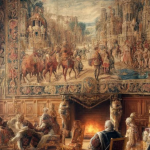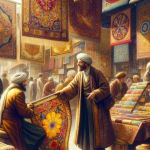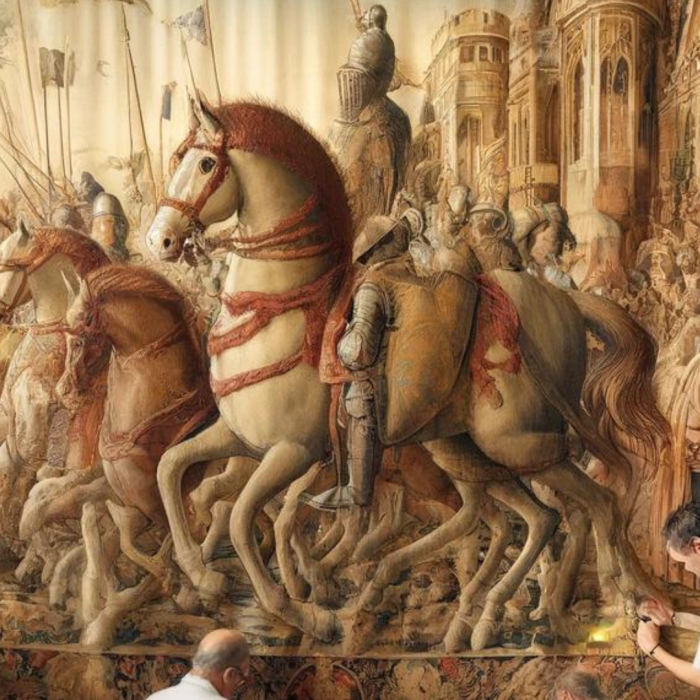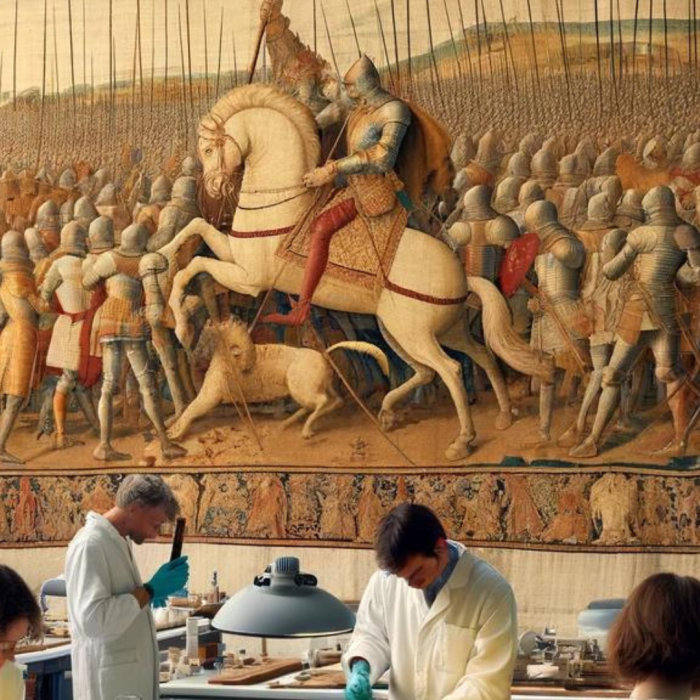Tapestry Patterns and their Meanings
Tapestries, a venerable form of textile art, have served more than just a decorative purpose throughout history. Originating from ancient civilizations, these intricately woven artworks have been pivotal in storytelling, preserving myths, and commemorating historical events. The patterns embedded within tapestries are not merely aesthetic; they are laden with stories, offering a window into the cultures and ideologies of their creators. This section delves into the rich tapestry of tapestry art, illuminating its significance as a storytelling medium.
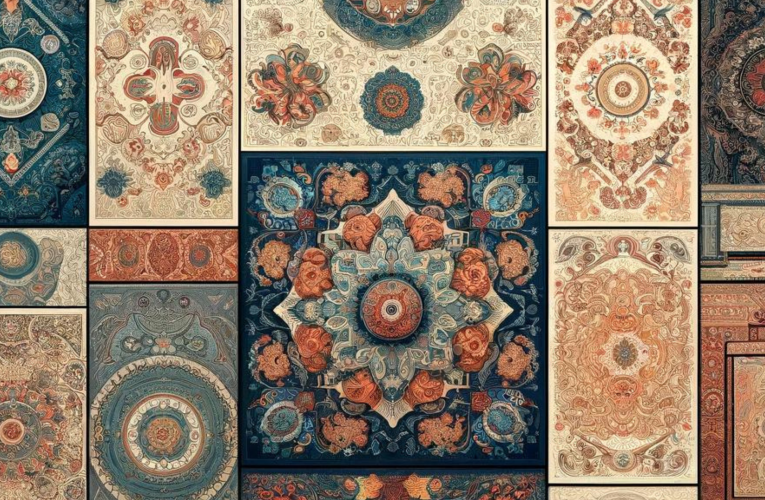
Historical Background
The art of tapestry-making can trace its roots back to the ancient Egyptians, but it was during the Middle Ages and the Renaissance that it truly flourished in Europe. These eras witnessed the creation of tapestries that were not only magnificent in scale and beauty but also rich in narrative depth. Kings and noblemen commissioned these elaborate works of art to depict battle victories, religious stories, and mythological scenes, using them as symbols of power and cultural identity. The famous Bayeux Tapestry, for instance, offers a visual recount of the Norman Conquest of England in 1066, demonstrating the tapestry’s role in recording history.
Techniques and Materials
Unlike other textile arts, tapestry weaving is unique in its method of construction. It involves the interlacing of two sets of threads, the warp and the weft, to produce intricate patterns and images. Historically, wool was the most common material, often supplemented with silk, gold, or silver threads to add vibrancy and luxury. This technique allowed for the creation of detailed and complex imagery, making tapestries a highly esteemed form of art.
Tapestries as Storytellers
Tapestries have long been employed as narrative tools, intricately woven with the legends, beliefs, and ethos of their times. They served not only as artistic expressions but also as historical documents that encapsulate the societal values and stories of their creators. The Bayeux Tapestry, with its detailed depiction of the Norman Conquest, is a prime example of how tapestries were used to narrate significant historical events, immortalizing them in the collective memory of future generations.
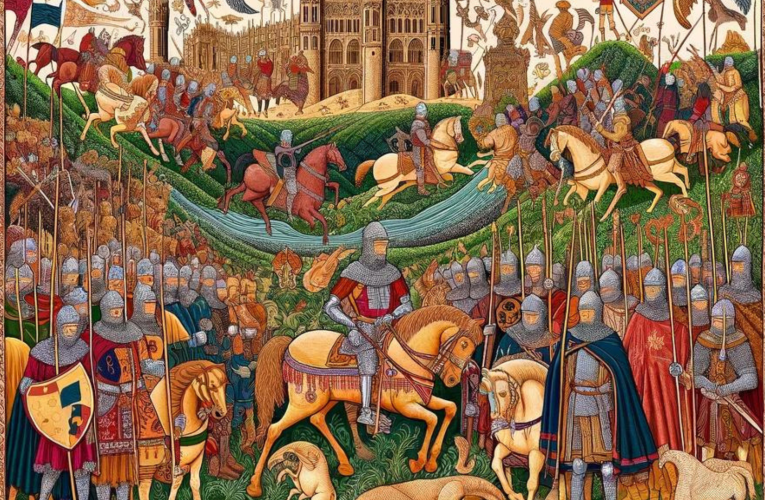
Symbolism and Patterns
The patterns and motifs in tapestries are deeply symbolic, often reflecting the political, spiritual, and cultural currents of the time. From heraldic emblems representing noble families to mythological creatures symbolizing virtues or vices, every pattern has a story, a piece of a larger narrative puzzle. Understanding these symbols provides a deeper insight into the historical and cultural contexts from which these tapestries emerged, making them invaluable cultural artefacts.
Tapestries are much more than mere decorative items; they are vibrant chronicles of human history, woven with the threads of storytelling, craftsmanship, and symbolism. By exploring the patterns and narratives within tapestries, we not only appreciate their artistic value but also connect with the rich tapestry of human culture and history they represent.
This overview offers a glimpse into the profound role tapestries have played in art and storytelling, inviting readers to delve deeper into the patterns and meanings that make each piece a unique testament to its era.
Importance of Patterns in Expressing Cultural, Historical, and Personal Values
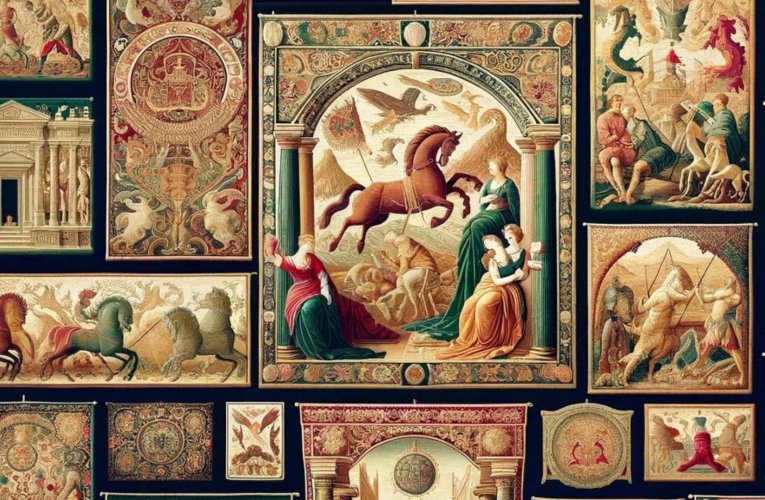
The Historical Significance of Tapestry Patterns
The art of tapestry weaving is a tradition as ancient as it is rich, serving as a historical ledger that records the shifting landscapes of human civilization. Tapestry patterns, with their intricate motifs and vibrant colors, are more than mere decorations; they are a window into the past, offering insights into the lives, beliefs, and societies of their creators.
Early Beginnings and Evolution
Tapestry weaving dates back to ancient civilizations, where they adorned the walls of palaces and temples, serving both aesthetic and practical purposes. The patterns woven into these early tapestries often depicted mythological stories, celestial events, and everyday life, symbolizing the values and knowledge of the time. As tapestry art traveled through the ages, from the ancient Egyptians to the Greeks and Romans, and later through the Byzantine Empire and into medieval Europe, the complexity and significance of its patterns grew.
Medieval Mastery
The Middle Ages marked a golden era for tapestry weaving in Europe. Tapestries became symbols of wealth and power, adorning the halls of castles and churches. The patterns of this era often depicted religious stories, chivalric scenes, and heraldic motifs, reflecting the societal hierarchy and the pervasive influence of the Church. The famous “Bayeux Tapestry” is a prime example, chronicling the Norman conquest of England with intricate detail and narrative depth.
Renaissance Riches
The Renaissance brought about a transformation in tapestry art, with patterns becoming increasingly elaborate and sophisticated. Artists began to draw on classical mythology and historical events, weaving them with a realism previously unseen. This period saw the rise of workshops in France and the Netherlands, which produced some of the most magnificent tapestries known today. These artworks were not only decorative but also served as propaganda tools and symbols of royal prestige.
Reflection of Societal Changes
Throughout history, tapestry patterns have mirrored the political, social, and economic shifts of their times. From the depiction of colonial conquests and trade routes in the 16th and 17th centuries to the incorporation of floral and pastoral themes during the Rococo period, tapestries have adapted to reflect the changing tastes and values of society. In times of war and peace, prosperity and famine, tapestry patterns have provided a vivid tapestry of human history, woven with the threads of collective experience.
Historical Overview of Tapestries
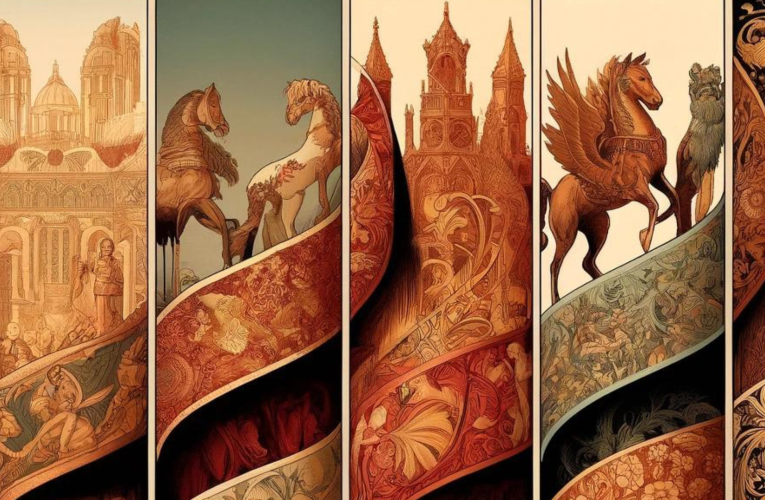
Tapestries are woven artworks that combine decorative beauty with storytelling and historical documentation. They have been a significant part of human culture, transcending geographical boundaries and epochs. Initially, tapestries served both functional and symbolic purposes, from providing insulation in cold castle rooms to depicting tales of victories and valor for posterity.
Brief History of Tapestry Making Across Different Cultures
The earliest tapestries date back to ancient civilizations, where they adorned the walls of palaces and temples. In medieval Europe, tapestry making flourished as a sophisticated art form, with France and Belgium becoming centers of excellence. The famed Gobelins Manufactory in Paris, for instance, was synonymous with the highest quality tapestries. Simultaneously, in Asia, countries like China and Japan developed their unique tapestry traditions, often imbued with symbolic meanings related to their cultural beliefs. The Americas too have a rich history of textile art, with pre-Columbian cultures excelling in intricate weavings that often had spiritual or societal significance.
Evolution of Tapestry Weaving Techniques and Materials
Tapestry weaving started with simple techniques and materials available locally to artisans. Over centuries, the craft saw innovations such as the introduction of the Jacquard loom in the 19th century, revolutionizing how tapestries were made. The materials used evolved from basic wool to include silk, gold, and silver, making tapestries even more valuable and sought after.
The Role of Tapestries in Historical and Royal Settings
In historical and royal contexts, tapestries were more than mere decorations. They were status symbols, showcasing the wealth and cultural sophistication of their owners. Iconic pieces like the Bayeux Tapestry serve as historical documents that provide insight into the events they depict, such as the Norman Conquest of England in 1066.
Understanding the rich history of tapestry making allows us to appreciate the depth and significance of tapestry patterns seen today. As we move to explore these patterns and their meanings, we carry with us the knowledge of centuries of human creativity and expression woven into the very fabric of history.
This approach ensures the blog post not only educates but also engages the reader by painting a vivid picture of tapestry art’s evolution and enduring legacy.
Common Tapestry Patterns and Their Meanings
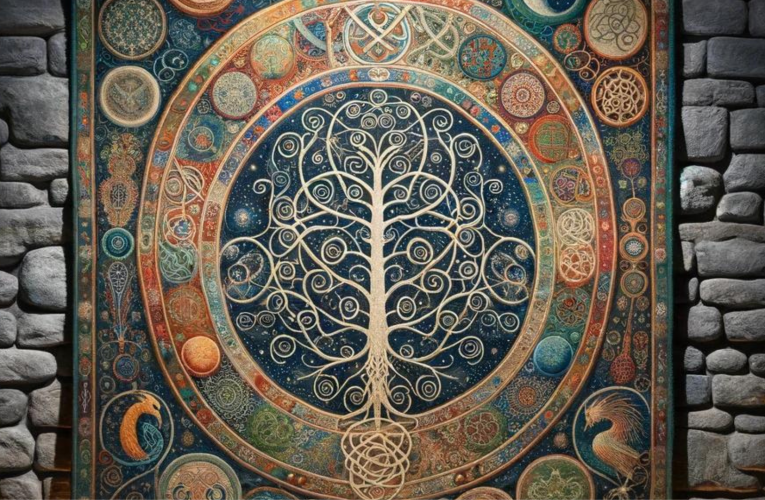
Tapestries, with their intricate weaves and vibrant hues, have adorned the walls of castles, churches, and homes for centuries, transcending their role as mere decorations to become storied canvases that capture the essence of human experience. Unlike any other form of art, tapestries are a testament to the craftsmanship and creativity of their weavers, embodying the cultural values, beliefs, and narratives of their time. At the heart of these woven narratives are patterns and symbols, each with its own story to tell, conveying messages of love, faith, valor, and the eternal cycle of life itself.
As we unravel the threads of common tapestry patterns and their meanings, we embark on a journey through time and across cultures. From the luscious gardens of floral and botanical motifs to the dynamic portrayal of animal imagery, the precision of geometric patterns, the divine tales of mythological and religious themes, and the serene beauty of landscape and scenic depictions, tapestries offer a unique window into the human soul and the natural world. Join us as we explore the rich symbolism woven into these historical textiles and discover the stories they tell.
- Floral and Botanical Patterns
- The use of flora in tapestry art is as diverse as the natural world itself, with each flower, leaf, and tree imbued with its own symbolic meaning. These patterns do more than merely mimic the beauty of nature; they weave a complex language of symbolism, where a single flower or plant can narrate tales of love, sorrow, purity, or power.
- Roses, often hailed as the queen of flowers, are a common motif, symbolizing love, beauty, and the fleeting nature of life. In contrast, the lily, with its pristine petals, stands for purity and renewal, often associated with the Virgin Mary in Christian iconography. The oak tree, a recurring theme in tapestries, embodies strength, stability, and endurance, echoing the ancient belief in its sacredness.
- These symbols, however, are not universal. The bamboo in Chinese tapestries speaks of resilience, flexibility, and integrity, while the lotus, revered in both Hinduism and Buddhism, symbolizes enlightenment, purity, and the soul’s expansion beyond the mud of its origins. The thistle, often found in Scottish weaves, tells stories of resilience and defense.
- Famous tapestries like the medieval “Millefleur” (thousand flowers) backgrounds or the “Unicorn Tapestries” are exemplary for their rich floral symbolism, serving as a backdrop to allegories and narratives. These motifs were not chosen at random but were laden with meanings, reflecting the beliefs, values, and artistic tastes of the time.
- Through the lens of specific cultures and historical periods, floral and botanical patterns in tapestries reveal a tapestry of their own—a rich, intertwined narrative of humanity’s relationship with nature, encoded in threads that have stood the test of time.
- Animal Motifs
- In the woven world of tapestries, animals are not merely subjects of aesthetic appreciation but are rich with symbolic significance. These motifs serve as emblems of virtues, vices, and divine messages, often reflecting the cultural and spiritual beliefs of the societies that created them.
- Lions, with their majestic manes and formidable presence, are commonly depicted in tapestries as symbols of courage, power, and royalty. In medieval Europe, the lion was not just a king of the beasts but also represented the valor and authority of noble families, as seen in heraldic tapestries.
- Doves, in stark contrast, offer a gentle symbol of peace, purity, and the Holy Spirit within Christian iconography. Their presence in tapestry art often signifies a message of hope and reconciliation.
- The incorporation of mythical creatures such as dragons and phoenixes into tapestry designs brings an additional layer of meaning, intertwining with the real to symbolize the transcendental. Dragons, with their fearsome countenance, often represent chaos and challenge, while the phoenix symbolizes rebirth, immortality, and the cyclical nature of life and resurrection.
- Animal symbolism in tapestries extends beyond the borders of Europe. In Persian art, the deer is often depicted as a symbol of longing and the soul’s quest for spiritual knowledge. Meanwhile, in Native American tapestries, animals like the eagle for vision and leadership, and the bear for strength and wisdom, play a central role in conveying the spiritual and cultural ethos of different tribes.
- Geometric Patterns
- Beyond the realms of the natural and mythical, tapestries often feature a wide array of geometric patterns, each carrying its own symbolic weight and aesthetic appeal. These patterns, ranging from simple shapes to complex arrangements, are more than just decorative elements; they are imbued with deep meanings, reflecting the philosophical and cosmological concepts of their creators.
- The spiral, a simple yet profound geometric shape, is found in many cultures’ tapestries, symbolizing growth, evolution, and the eternal cycle of life and death. Celtic tapestries, in particular, are renowned for their intricate knotwork and spirals, representing the interconnectedness of all things and the continuity of life.
- Lattice patterns, with their interlocking designs, symbolize the structure of the cosmos and the interconnectedness of the physical and spiritual realms. In Islamic art, where the depiction of living beings is often avoided, geometric patterns achieve a high level of sophistication, embodying the infinite nature of the divine.
- In contemporary designs, geometric patterns continue to evolve, often taking on more abstract and symbolic interpretations. They can represent modernity, stability, or the chaotic nature of the digital age, demonstrating the versatility and enduring appeal of geometric designs in tapestry art.
Mythological and Religious Themes
Tapestries have long served as a canvas for the divine and the legendary, weaving together the threads of gods, goddesses, and sacred narratives with the human experience. These works not only depict mythological and religious tales but also serve as a medium for instruction, inspiration, and contemplation.
The Greek pantheon, with its array of gods and goddesses, heroes and monsters, has been a rich source of inspiration for tapestry artists. The Labors of Hercules, for example, not only showcase the hero’s strength and cunning but also offer moral lessons on bravery, perseverance, and the human condition.
In Christianity, tapestries have been used to depict key biblical stories and figures, from the Creation to the Last Supper, serving both an educational and inspirational purpose. The Unicorn Tapestries, though shrouded in mystery, are thought to contain Christian symbolism, representing purity, the passion of Christ, and the Resurrection.
Islamic art, with its emphasis on aniconism, finds expression in tapestries through calligraphy and abstract designs, conveying the divine through the beauty of the written word and geometric perfection. Verses from the Quran, woven into tapestries, serve as reminders of the faith and guidance for the believer.
Hindu and Buddhist tapestries depict a vast array of deities and spiritual stories, such as the Life of Buddha or the epic tales of the Mahabharata and Ramayana. These tapestries serve as teaching tools, guiding the observer through the principles of dharma (duty/righteousness) and the paths to enlightenment.
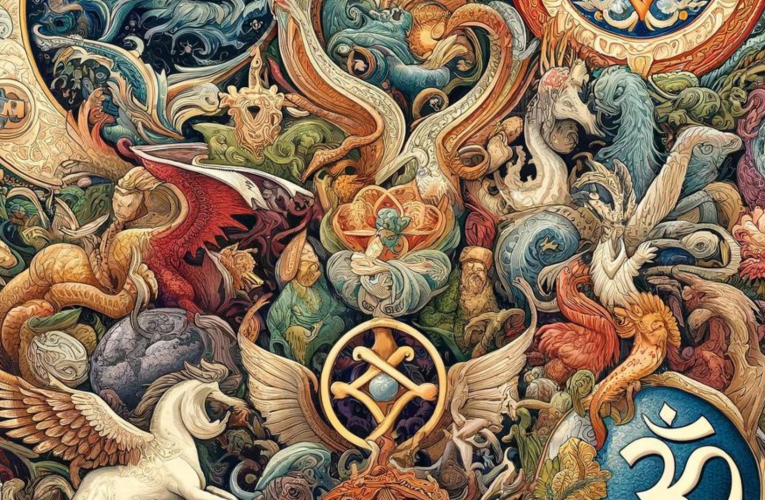
Landscape and Scenic Depictions
Moving from the celestial to the terrestrial, tapestries also offer breathtaking landscapes and scenic depictions that go beyond mere representation. These works capture the essence of a place, a moment in time, or a mythical world, inviting the viewer into a woven panorama filled with depth, perspective, and narrative.
The Verdure tapestries, lush with foliage, trees, and sometimes animals, are not just celebrations of nature’s beauty but can also be read as symbols of fertility, abundance, and the Garden of Eden. These works often carry an air of tranquility and a reminder of the world’s untouched purity.
The Battle of Hastings Tapestry, also known as the Bayeux Tapestry, is a remarkable historical record, providing a detailed narrative of the events leading up to the Norman conquest of England in 1066. Through its depiction of landscapes, figures, and battles, it offers insights into medieval life, warfare, and the landscape of 11th-century England.
Contemporary tapestries continue to explore the potential of landscapes as a means of storytelling and reflection. Whether depicting urban sprawls, untouched wilderness, or imagined realms, these tapestries invite contemplation on our relationship with the environment, history, and the possibilities of the future.
The Process of Creating a Tapestry
Tapestry making is an art form that combines creativity, patience, and meticulous skill, unfolding through various stages from conception to completion. This process can be divided into traditional and modern techniques, each contributing uniquely to the art’s evolution.
Traditional Tapestry Making: Historically, tapestry making begins with the artist or designer creating a detailed sketch or pattern, known as a cartoon, which serves as the blueprint for the weaver. The weaver then sets up a warp on a loom—a set of vertical threads that will form the tapestry’s backbone. Using a variety of colored threads, the weaver interlaces the weft threads over and under the warp, following the cartoon’s design meticulously. This method demands a high level of craftsmanship and can take months or even years to complete, depending on the complexity and size of the tapestry.
Modern Techniques: The advent of technology has introduced new methods into tapestry making, such as digital looms and computer-aided design (CAD) software. These modern tools allow for the precise and efficient creation of tapestries, enabling artists to experiment with more complex designs and a broader palette of colors. Digital tools have also democratized tapestry making, making it more accessible to artists without traditional weaving skills.
Despite these technological advances, many artists and weavers continue to cherish and practice traditional tapestry making techniques, valuing the tactile connection to the material and the historical continuity it provides. In today’s tapestry scene, a fascinating blend of old and new methods coexists, allowing for a rich variety of artistic expression and innovation within this ancient craft.
Through this detailed journey from design to weaving, tapestry making remains a testament to human creativity and our enduring desire to blend beauty with storytelling, whether through the time-honored threads of tradition or the modern pathways of technological advancement.
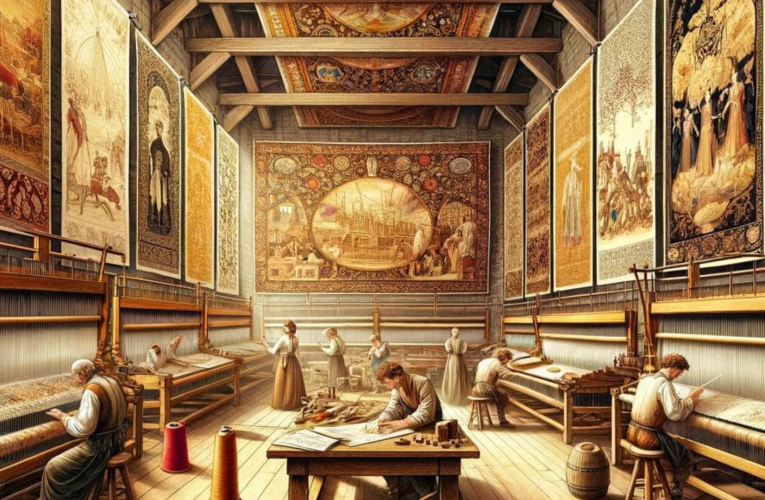
Tapestry Patterns in Modern Decor
In the ever-evolving world of interior design, the blending of old and new is a recurring theme that brings depth and character to modern spaces. Among the rich traditions being revived and reimagined in contemporary decor, tapestry patterns stand out as a testament to the enduring appeal of woven narratives. Through the lens of modern design sensibilities, traditional tapestry patterns are not only preserved but also transformed, serving as a bridge between the past and the present. This exploration sheds light on how contemporary designers incorporate these historic motifs into modern decor and the significance of choosing specific patterns for personal spaces.
Incorporating Traditional Patterns into Modern Decor
Contemporary designers often draw inspiration from the vast array of traditional tapestry patterns, each with its own history and symbolism. By incorporating these patterns into modern decor, designers can infuse spaces with a sense of continuity, grounding cutting-edge design with elements of cultural heritage. Here’s how they do it:
Fusion of Styles: Traditional tapestry patterns are seamlessly integrated into modern decor through furniture, wall hangings, and textiles. This fusion creates a vibrant juxtaposition that celebrates both the old and the new.
Reinterpretation of Motifs: Designers reinterpret classic motifs with contemporary techniques and color palettes, making them more accessible and relevant to today’s aesthetics. This approach allows traditional designs to resonate with modern audiences.
Strategic Placement: Tapestries are often used as focal points in minimalist or contemporary settings, where their intricate patterns can draw the eye and add warmth and texture to the sleek lines of modern design.
Customization: With advances in technology, it’s now possible to customize traditional tapestry patterns for specific spaces, allowing for a personal touch that speaks to the individual’s style and the room’s overall design theme.
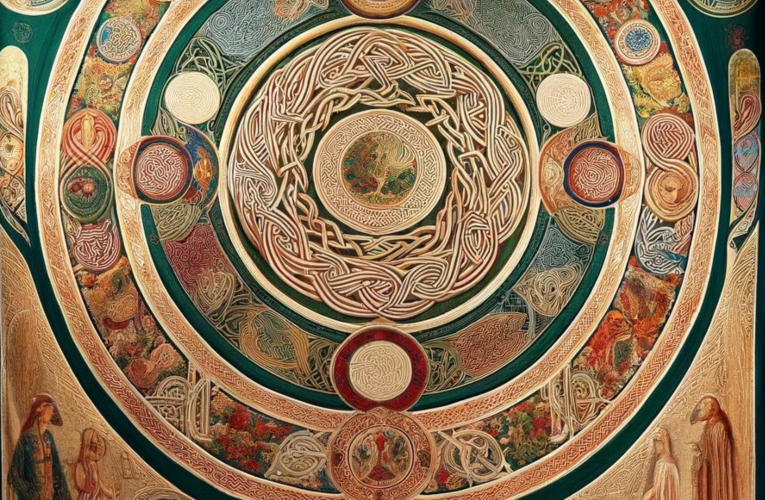
Significance of Choosing Certain Patterns for Personal Spaces
The choice of tapestry patterns goes beyond mere aesthetics; it’s a reflection of personal identity, cultural connections, and the atmosphere one wishes to create in their space. Here’s why pattern selection matters:
Symbolism and Storytelling: Many tapestry patterns are rich in symbolism, carrying stories and meanings passed down through generations. Choosing a pattern with specific symbolism can imbue a space with a narrative layer, adding depth and interest.
Cultural Expression: For many, tapestry patterns are a way to express cultural heritage and pride. Incorporating patterns that reflect one’s cultural background can create a sense of belonging and identity within a space.
Psychological Impact: Patterns can have a significant impact on the mood and atmosphere of a room. Geometric patterns might evoke a sense of order and balance, while organic, flowing designs can create a calming and restorative environment.
Personalization: The choice of a particular tapestry pattern allows for a high degree of personalization in decor, enabling individuals to showcase their unique tastes and preferences. This personal touch makes the space more inviting and reflective of the owner’s personality.
The incorporation of tapestry patterns into modern decor is more than just a trend; it’s a celebration of history, culture, and personal expression. As contemporary designers continue to explore and reinterpret these traditional motifs, they open up new avenues for creativity and storytelling in interior design. Choosing a tapestry pattern becomes a deeply personal decision, one that enhances the connection between the individual and their space. Through this melding of past and present, tapestry patterns continue to enrich our lives, adding meaning and beauty to the places we call home.

